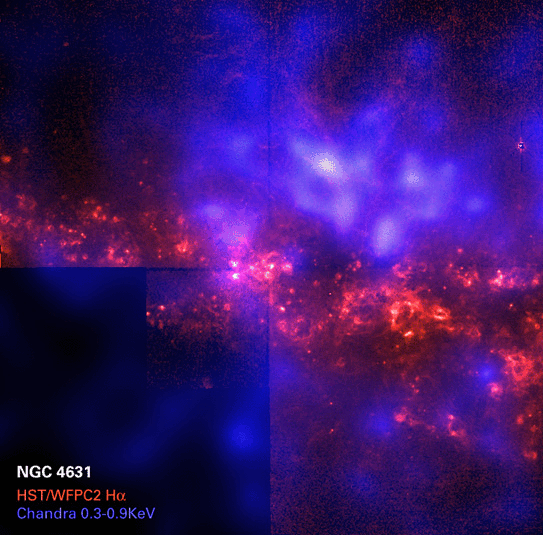
This research focuses on the study of galactic outflows, their interaction with the intergalactic medium (IGM) and the mass (metals) and energy injection in the IGM of groups and clusters of galaxies. Moreover, galaxy groups show conspicous features in soft X-ray emission observed with the Chandra and XMM-Newton satellites, which need to be explained.
There is now ample observational
evidence that galaxies are not isolated systems, but are characterized
by interaction with their environment. This can happen in a variety of
ways: infall of gas left over from galaxy formation or by tidal
interaction with neighbouring galaxies, galaxy-galaxy collisions
(including major mergers), ram pressure stripping of gas from high
velocity galaxies plunging into sufficiently dense IGM regions, and by
gas outflows triggered by star formation in the galactic disk. The
latter process, also termed galactic wind if the gas can escape from
the galaxy's gravitational potential, is particularly important,
because the outflowing gas stems from supernova remnants and
superbubbles and is therefore chemically enriched. Galactic winds are
therefore believed to play a key role in generating the high
metallicities observed in the intracluster medium (ICM).
Galactic Outflows:
Most galaxies show evidence of a gaseous halo surrounding the disk. These halos can be observed in many wavelengths, e.g. UV (as thick disks), soft X-rays (due to hot gas breaking out of the disk, triggered by star formation), and radio continuum (synchrotron emission from relativistic cosmic ray electrons in halo magnetic fields).

Fig. 4 : A close-up of a composite image of the nearby edge-on spiral galaxy NGC4631 is shown. In red, the diffuse ionized gas in Hα can be seen, as observed by the Wide-field Planetary Camera 2 (WFPC2) onboard the Hubble Space Telescope (HST). This traces the regions of star formation, in particular the gas around massive stars, which are also responsible for supernova explosions. In blue colour coded, the diffuse soft X-ray emission, as observed with the Chandra X-ray Observatory, is overlaid, emphasizing the tenuous hot supernova shock heated gas. The image nicely demonstrates the correlation between star formation and and hot gas breaking out of the galactic disk and filling a large kiloparsec scale galactic halo. These results are published in Wang, Q.D., Immler, S., Walterbos, R., Lauroesch, J.T., Breitschwerdt, D., Astrophys. J. Letters 2001, 555, L99.
X-ray Spectral Modeling of Galactic Halos:
In order to study the origin and characteristics of galactic outflows, observations in soft X-rays with sufficiently high spectral resolution are ideal as they are tracing the hot gas. For long time it has been common in order to model the spectra, obtained from X-ray satellites such as ROSAT, ASCA, Chandra and XMM-Newton, to assume that the hot emitting gas is in collisional ionization equilibrium (CIE). This means that collisional ionization (involving 3 particles, an electron colliding with an ion plus an electron ejected from the ion) is balanced by radiative recombination (involving 2 particles and a photon, which is emitted upon recombination of the electron with an ion). It is obvious that physically such a balance cannot exist, since both processes are cooling the plasma: during collisional ionization a substantial amount of the kinetic energy of the colliding electron is used up for overcoming the ionization potential of the ion, and, in radiative recombination, the photon, which is carrying away the energy gained, is lost as reabsorption is very unlikely in optically thin X-ray plasmas. In addition, the time scales for ionization and recombination are vastly different for each ion and independent of the plasmas' characteristics, solely fixed by atomic physics. Yet, there was some hope that to some approximation the ionization structure would be in equilibrium. However, we have shown (Breitschwerdt & Schmutzler 1994, Nature 371, 774) that in galactic outflows, in which adiabatic expansion can be an important process, the time scale for adiabtic cooling could be the shortest, leading to a situation, in which the ionization stages are "frozen" into the plasma, and hence to what is called delayed recombination. We could show that in such a non-equilibrium ionization (NEI) situation a plasma, which is 100 times cooler than normally, can still emit soft X-ray photons.
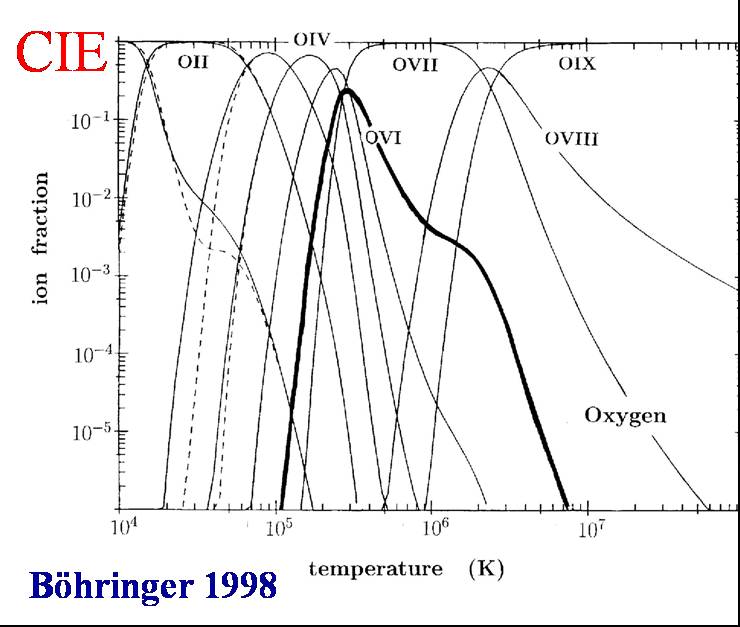
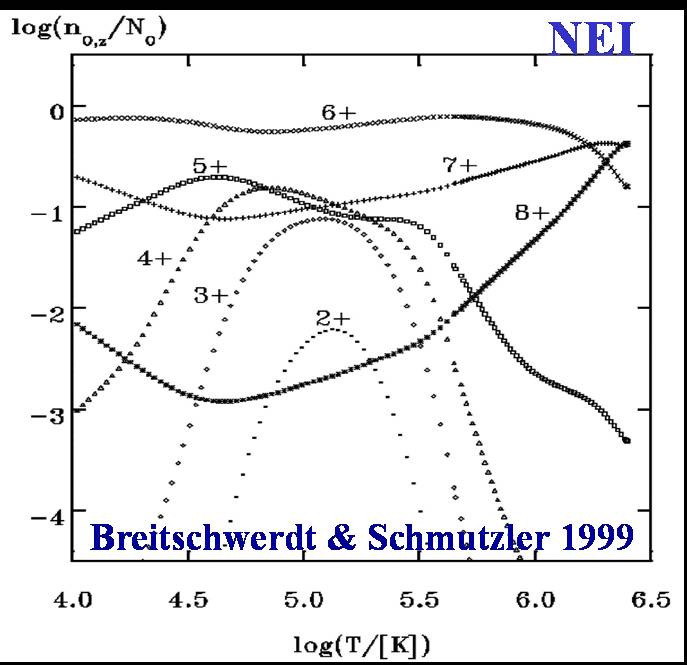 Fig. 5 (Left): Ionization
fraction of oxygen ions in CIE, depending only on temperature (taken
from Böhringer 1998, in "The Local Bubble and Beyond",
Springer LNP 506, p. 345, eds. D. Breitschwerdt et al). (Right):
Ionization fraction of oxygen ions in NEI, depending crucially on the
astrophysical outflow model (similar to Breitschwerdt &
Schmutzler 1999, Astron. Astrophys. 347, 650).
Fig. 5 (Left): Ionization
fraction of oxygen ions in CIE, depending only on temperature (taken
from Böhringer 1998, in "The Local Bubble and Beyond",
Springer LNP 506, p. 345, eds. D. Breitschwerdt et al). (Right):
Ionization fraction of oxygen ions in NEI, depending crucially on the
astrophysical outflow model (similar to Breitschwerdt &
Schmutzler 1999, Astron. Astrophys. 347, 650).
The observed spectrum would thus bear the signature of the dynamics of the outflow, because the location at which ionized species would eventually recombine would be determined by the outflow velocity and the local density. Hence spectral modeling has to be self-consistent in the sense that the dynamics would be modified by non-equilibrium cooling, which in turn would change the spectral characteristics of the outflow. The effects of delayed recombination on the spectra would be particularly strong in starburst galaxies, which are characterized by a temporally enhanced star formation rate; nearby examples are M83, NGC 253.
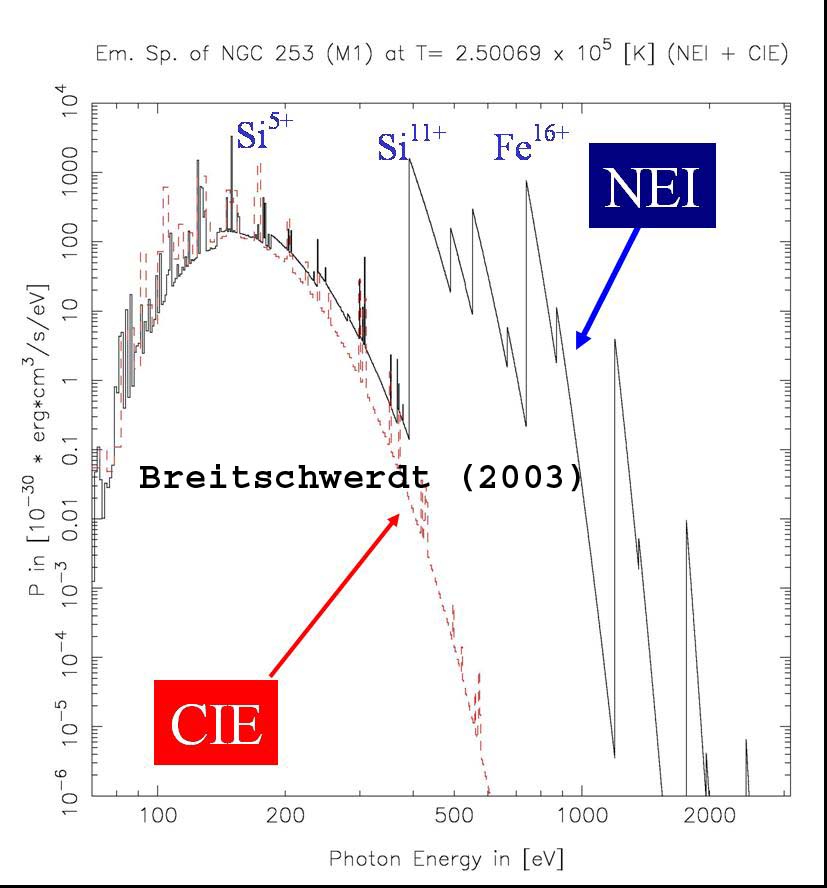
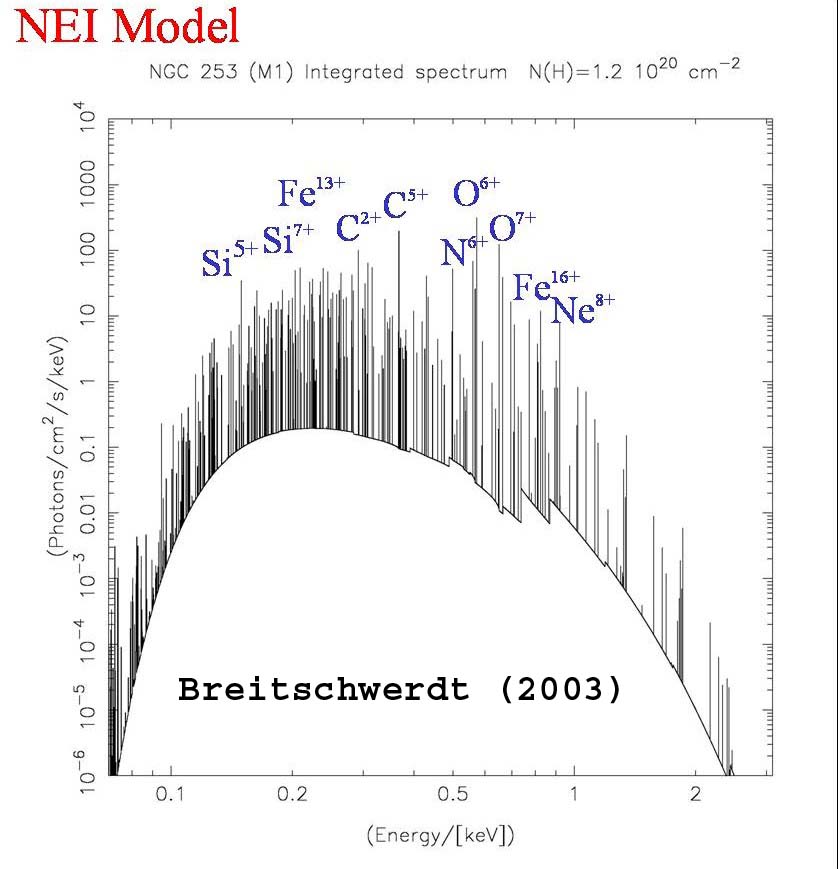
Fig.6 (Left): Intrinsic X-ray spectrum (emitted power normalized to density squared versus energy in eV) of a simulated galactic wind of the galaxy NGC 253, tracing the time-dependent NEI structure in comparison to a CIE model at the same intrinsic temperature of 2.5 105 K. Note the difference in the spectra due to delayed recombination! (Right): NEI integrated halo spectrum of NGC 253 (in units of photons/cm2/s/keV versus energy in keV, including Galactic absorption); the major ions contributing to the spectrum are indicated (taken from Breitschwerdt 2003, unpublished).
Fig. 5 shows a comparison between
the CIE and NEI X-ray spectrum for a temperature of 2.5 million K.
Whereas the CIE spectrum is fixed and depends only on the temperature,
the time-dependent NEI spectrum depends of the outflow characteristics.
Although fitting of X-ray spectra becomes more difficult in NEI, it
offers the unique possibility to derive the outflow characteristics
from spectral modeling. Having developed a self-consistent X-ray
spectral fitting procedure, we have so far derived outflow models for
the galaxies NGC 253 and NGC 3079.